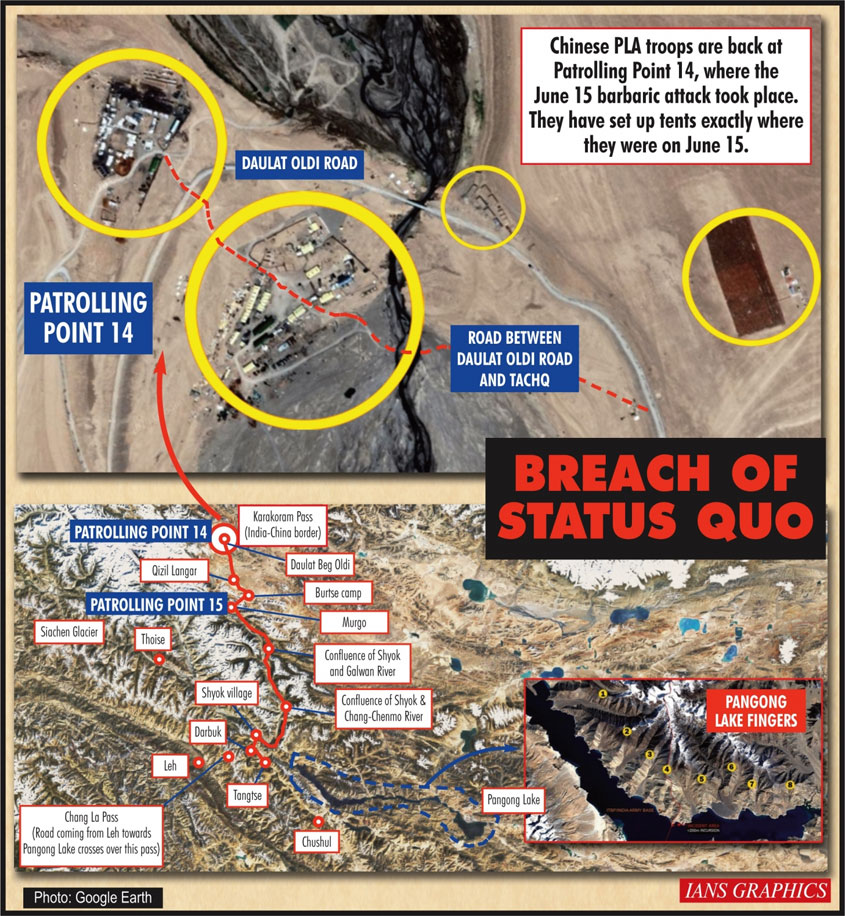Defying consensus, China ramps up military presence along Galwan Valley

Mail This Article
New Delhi: Defying the agreed consensus to disengage, Chinese People's Liberation Army troops have returned to Patrolling Post 14 on the Line of Actual Control in Galwan Valley in eastern Ladakh.
Even as military and diplomatic talks are on to ease tension along the LAC, China has significantly ramped up its military presence in Pangong Tso, Galwan valley and several other friction points in eastern Ladakh.
Chinese military has also deployed a sizeable number of its troops in Galwan Valley, the site of the violent clashes on June 15 that left 20 Indian soldiers dead.
The erection of a surveillance post by China in the area had triggered the clashes.
The PLA has even set up tents and an observation point exactly where it was on June 15, notwithstanding India's stiff opposition.
Over the last few days, China has been laying claim over Galwan Valley though India called it "untenable".
Besides Pangong Tso and Galwan Valley, the two armies are also locked in a standoff in Demchok, Gogra Hot Spring and Daulat Beg Oldie in eastern Ladakh. A sizeable number of Chinese Army personnel transgressed into the Indian side of the LAC.
China has also increased the number of troops and weaponry in several other key sectors along the Line of Actual Control in Arunachal Pradesh, Sikkim and Uttarakhand, the people cited above said.
The increase in military build-up by China along the LAC, the de-facto border between the two countries, came amid bilateral diplomatic and military talks.
Senior military commanders of the two armies on Monday held a nearly 11-hour meeting during which they arrived at a "mutual consensus" to "disengage" from all the friction points in eastern Ladakh in a gradual manner.
The two sides on Wednesday held diplomatic talks under the framework of Working Mechanism for Consultation and Coordination on India-China Border Affairs.

In the meeting, both sides agreed to ensure expeditious implementation of the understanding on disengagement of troops from eastern Ladakh as decided in a meeting of senior military commanders on June 6, the Ministry of External Affairs said.
In the midst of fast-paced developments, Army Chief Gen M M Naravane on Wednesday visited various forward areas in eastern Ladakh and reviewed the Army's operational preparedness.
On the second day of his visit to Ladakh, Gen Naravane took stock of the Army's combat preparedness in four forward areas and interacted with soldiers deployed there besides holding detailed deliberations with ground commanders.
The Army Chief reviewed the overall security situation in the region with Northern Army Commander Lt Gen Yogesh Kumar Joshi, commander of the 14 Corps Lt Gen Harinder Singh and other senior Army officials on both Tuesday and Wednesday, sources said.
The Chief of Army Staff is expected to return to the national capital on Thursday.
"General M M Naravane #COAS visited forward areas in Eastern #Ladakh and reviewed the operational situation on the ground. #COAS commended the troops for their high morale and exhorted them to continue working with zeal and enthusiasm," the Army said in a tweet.

The sources said India is also bolstering its military presence along the 3,500 km LAC with China.
On Sunday, the government gave the armed forces "full freedom" to give a "befitting" response to any Chinese misadventure along the LAC.
The Army has already sent thousands of additional troops to forward locations along the border in the last one week.
The IAF has also moved a significant number of its frontline Sukhoi 30 MKI, Jaguar, Mirage 2000 aircraft and Apache attack helicopters to several key air bases including Leh and Srinagar following the clashes.
The situation in eastern Ladakh deteriorated after around 250 Chinese and Indian soldiers were engaged in a violent face-off on May 5 and 6. The incident in Pangong Tso was followed by a similar incident in north Sikkim on May 9.
Prior to the clashes, both sides had been asserting that pending the final resolution of the boundary issue, it was necessary to maintain peace and tranquillity in the border areas.
(With inputs from PTI and IANS)


